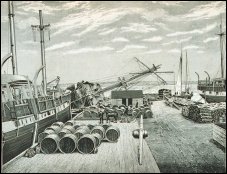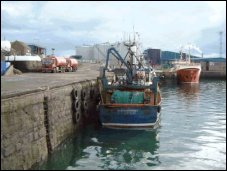| The Peterhead whaling trade |
|
Home |
Extracting the oil - the boilyards
Once back in Port the barrels of blubber were unloaded and taken to the premises where the oil was extracted. In Peterhead the whalers docked at the Blubber Box Quay in the south harbour and the barrels were carted a short distance to the boilyards on Keith Inch. The blubber was boiled in copper vessels of up to 10 tons or more capacity. These were round in section and raised about 6 feet above a furnace. A pipe, fitted with a stopcock, led from the boiler to wooden coolers lined with lead or cement and each capable of holding 10 tons of oil. Oil was run from the coolers directly into casks. By the time the ships arrived in port, much of the oil had separated from the firm, fatty blubber. The contents of the barrels were simply poured directly into the boilers, filling them almost to the top. The fire was then lit and the oil brought to the boil. Throughout the heating the contents were stirred with a wooden pole to prevent any solids sticking to the sides and burning. When the oil began to boil the fire was reduced allowing the boil to gently boil for 1-3 hours. Usually two loads of blubber could be boiled every 24 hours, the Sabbath excepted. Once cooled, the oil was in a state ready for immediate use and was simply transferred from the coolers into wooden barrels ready for shipment throughout the land. |

